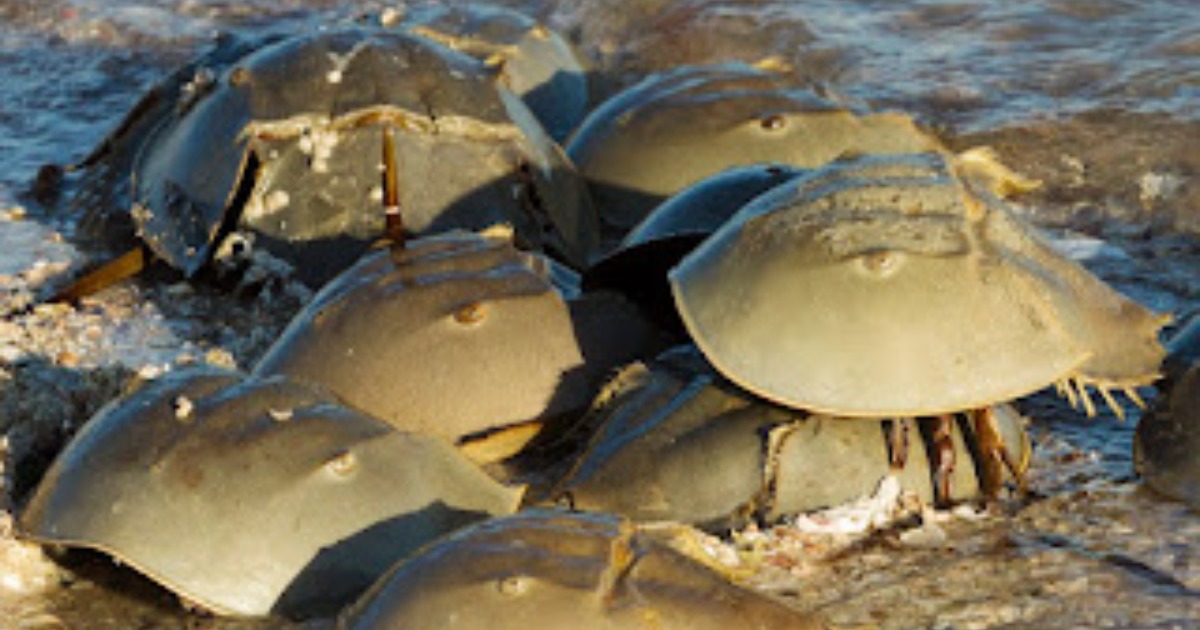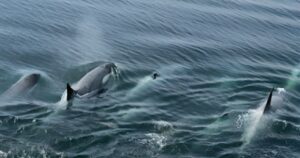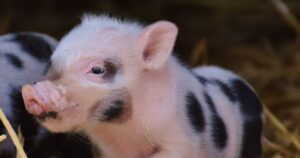Back in 1970, folks began extracting blood from this arthropod, and before long it turned into the priciest fluid worldwide. But the reason they’re taking it out isn’t due to its high cost; they simply can’t stop extracting it. But why? Let’s find out.
Horseshoe crabs are super important to us humans; we can’t just replace them or forget about them because they play a crucial role. Right now, they’re a valuable asset for us—basically, it’s like catch them, get some of their blood, then let them go.
Finding a substitute for horseshoe crabs would be a positive step. Nevertheless, certain experts suggest that if such alternatives were to become available, it could impact the perceived value of horseshoe crabs in the market. Why?
Here’s the thing: when people found out how valuable live horseshoe crabs are, it did hurt their population. But it’s even worse for them to have no worth at all; that’s when they get caught just to be used as bait or a fancy meal. If horseshoe crabs don’t bring money anymore, people won’t bother keeping them alive. The problem isn’t just taking their blood; in recent years, their numbers have dropped because their homes near the coasts are being destroyed, and people are catching too many fish. Lots of other animals are dealing with these same issues, and horseshoe crabs are, unfortunately, among them.
So basically, things are not looking good for them; they might end up on the endless list of animals in danger that people don’t really care about. Remember that mouse species that went extinct in Australia a couple of years ago? Did you know that the mouse was actually endangered while it was still alive? My guess is you didn’t. That’s just the way this whole thing works. Basically, if we stop extracting blood from horseshoe crabs, they lose all value, and you know how that ends.
what horseshoe Crabs really are and why they matter so much to humans
Now let’s dive into what horseshoe crabs really are and why they matter so much to humans. I’ll start by saying that these creatures might not win any beauty contests, but that’s fine. Horseshoe crabs are incredibly ancient; some even call them living fossils because they’ve been around in some form for over 450 million years.
During that time, Earth has seen several major ice ages, a devastating event known as the great dying, the rise and fall of the supercontinent Pangea, and a huge asteroid impact that led to the extinction of dinosaurs and a lot of other species.
To put it simply, horseshoe crabs were able to endure what many others couldn’t. What’s their secret? Well, besides having a strong outer shell, they’re not fussy about food and thrive in aquatic environments. It’s also about the blood; that very same blood is now regarded as one of the most expensive liquids worldwide, costing about fifteen thousand dollars per quart.
Horseshoe Crabs Immune System
Back in the 1970s, pharmaceutical companies began using a substance from the blood of horseshoe crabs to ensure new medicines didn’t contain harmful bacteria. This all started with Frederick Bang, a researcher who wanted to understand how these ancient marine creatures’ immune systems were. Bang ran a series of tests on horseshoe crab blood, discovering that when he introduced bacteria from seawater into the arthropod’s bloodstream, the blood clumped together into a viscous mass to fight off infection. This finding turned into a crucial aspect of safety testing in modern medicine.
That’s because horseshoe crabs are pretty unique creatures; they’ve got this incredible immune system that’s totally unlike anything else. This helps them survive in places full of bacteria like the coastlines where they live when they’re spawning or during their early years. To handle all the germs, they had to come up with something, and what they figured out is pretty cool.
Benefits of Horseshoe Crabs
We’ve actually taken advantage of this discovery. You see, when horseshoe crab blood encounters harmful bacteria (endotoxins), it starts to form clots. These clots slow down the bacteria from spreading; it’s like a thick, sticky clot that forms super quickly. This nifty ability has some really useful applications. We use horseshoe crab blood to quickly and easily test things like new medicines, how clean needles are, or whether the water is safe. Anyway, what people do is they put a drop of a substance sourced from horseshoe crab blood into a medicine sample, and then they wait to see if it forms a clot or not.
Yeah. It’s that simple. Most of us have come across horseshoe crabs in some way without even being aware of it. This is because every medicine approved in the last 50 years has been tested using the blood of these very creatures. Essentially, horseshoe crabs have been protecting us throughout our lives, often without our knowledge. If I were a horseshoe crab, I might even feel a bit underappreciated.
Horseshoe crabs have actually saved each of us at least once in our lives. You see, their blood plays a crucial role in testing new vaccines for contamination. Those coveted COVID-19 vaccines we all got? Yep, they were also tested using horseshoe crab blood. Remember when you got your pet vaccinated for rabies? Horseshoe crabs helped make that safe too. And that pacemaker your loved one relies on? Well, give a shout-out to the horseshoe crab for that as well. Even the quality of artificial joints and implants owes a debt to these crabs. They’re the unsung heroes behind the safety of injectable medicines, IV solutions, and medical devices that get implanted in both humans and animals. It’s hard to imagine where we’d be without these amazing creatures.
Horseshoe Crabs Exciting Innovation
Scientists took things a step further by exploring how horseshoe crab blood could be used to detect primitive life forms on other planets. They inserted the blood enzymes into a portable device capable of detecting signs of life. When this device is exposed to microorganisms in soil, water, or any environment, the blood reacts in the same manner as it does in a lab setting—it clots. This clever research life hack comes down to this: if there are microbes in a sample from another planet, the blood thickens as soon as it encounters them. This exciting innovation implies that we might indeed uncover life beyond Earth, again thanks to the remarkable horseshoe crabs. I wouldn’t be too surprised if we eventually uncover that it was actually horseshoe crabs that launched rockets into space, built our cities, and set the foundation for humanity. Oh, this is very nice.
Let’s dive into the process of collecting precious blood from horseshoe crabs. Once these creatures are captured, they’re taken to the emergency room for a thorough examination and a gentle rinse to prepare them for their journey to the lab. In the lab, technicians carefully pierce the tissue around the crab’s hearts and insert a needle there. Usually, it takes the blood of two male horseshoe crabs to fill up a sample bottle. On the other hand, a female can be as much as 25 percent larger than males and typically just one of them is sufficient to fill the bottle.
Extracting Horseshoe Crabs blood
Usually, about 30 percent of a horseshoe crab’s blood is drawn over a span of 30 minutes. Once the blood’s collected, the animals are returned to the coastal waters where they were originally captured. Throughout the entire process, the horseshoe crabs are away from their natural habitat for around 48 hours. I mentioned the 30 for a reason; this specific amount of blood is taken to ensure the well-being of the animals.
However, it’s important to note that this procedure comes with consequences. It’s estimated that between 10 and 30 percent of the horseshoe crabs released after being milked don’t survive. That’s mostly because right after their blood is collected, horseshoe crabs tend to become sluggish and weak, making them vulnerable to predators. Moreover, female crabs don’t reproduce as actively and have fewer offspring after their blood is taken.
But it’s not just the blood extraction process that’s the problem. The deaths of horseshoe crabs often result from a combination of factors. They’re caught, transported, and sometimes not handled properly. On top of that, these creatures spend a considerable amount of time out of the water, which leads to stress and potential injuries.
Horseshoe Crabs consumed for delicacy
Now it’s time to ponder if some part of horseshoe crabs perishes due to all these manipulations, why not make use of them, save for eating?
Interestingly, in certain parts of Asia, horseshoe crabs are actually consumed and are even considered a delicacy. I haven’t personally tried them, but they say the flavor resembles various textures of crab and lobster. However, they’re not consumed everywhere or in large amounts because horseshoe crabs are already endangered and they hold significant importance for humans. While humanity won’t face extinction if horseshoe crabs disappear, efforts are underway to find something to replace them. At some point, some other alternative will be found. Nevertheless, considering the ongoing efforts to preserve their population, eating horseshoe crabs doesn’t seem like a wise idea.
problem with eating horseshoe crabs
There’s a problem with eating horseshoe crabs that have already died after giving blood. These crabs die in the wild underwater, which makes them tough to find. Subsequently, you’d have to retrieve them from the water, transport them, and sell them. In short, nobody’s gonna bother running around to find dead horseshoe crabs.
For now, there’s another approach. Horseshoe crabs, which are destined for cooking, are first borrowed by biomedical companies to extract their blood. After this process, they return to restaurants to be prepared as a delicacy. This is what horseshoe crabs’ habitat looks like. The main suppliers of their blood are Japan, China, and the United States.
However, in the U.S, there’s a legal prohibition against using these animals for anything else after lab procedures; they must be set free and left undisturbed. In Japan and Taiwan, horseshoe crabs are seen as a delicacy and are most frequently consumed there. In China, horseshoe crabs are also considered a food source, and they aren’t released there. If a horseshoe crab survives the blood extraction, it’s used for consumption; if it doesn’t survive, it’s utilized as fertilizer or traditional medicine. Thankfully, horseshoe crabs make up only a fifth of the market in these countries; the majority of these animals are much luckier than that.
People drink the blood of horseshoe crabs
And you know what the weirdest thing is? Some people drink the blood of horseshoe crabs. Yes, you heard right; the blood of this animal is said to be like nectar, and people include it in their diet to stay healthy. I just hope they don’t drink the blood in its pure form; it would be downright disgusting.
But what’s up with the alternative to horseshoe crab blood? Each year, more than 400,000 horseshoe crabs have their blood harvested, a tradition that’s continued for around 50 years. The count goes up annually, with the figure reaching 700,000 individuals in 2020.
Rabbits were used before horseshoe crab
The modern biomedical industry is too dependent on this blood. Before the horseshoe crab blood property was discovered, rabbits were used for testing. They were injected with the trial medicine, and if the rabbits developed a fever, the medicine was labeled dangerous in humans as it could cause fever, health problems, and even death. How many rabbits died during these tests? I think you can imagine. It’s only in recent years that pharmaceutical companies have finally committed to creating an alternative that doesn’t harm animals.
What’s more, a synthetic substitute for horseshoe crab blood has been available for about 20 years, but it’s not being used. Pharmaceutical companies that milk horseshoe crabs say that the synthetic substitutes are not sufficiently tested and safe. There are a number of additional tests to be done, and only then might they even be better. The important thing is that the transition to alternatives is smooth and that the horseshoe crabs themselves don’t go extinct because of it. Because it’s not just humans that are going to suffer.
Horseshoe crabs are part of the ecosystem
We’ve talked a lot about the importance of horseshoe crabs to us humans, but we somehow haven’t mentioned that they’re actually part of the ecosystem, which means they’re strongly connected to other animals. For example, the eggs of horseshoe crabs serve as food for striped bass and flounder, as well as Diamondback Terrapins, which are actually endangered. The fewer horseshoe crabs there are, the worse the situation will become
There are also migratory birds that count on the future offspring of horseshoe crabs. They need them to continue their migrations, and just imagine what would happen if these birds were deprived of such nutritious prey. Essentially, one link in the food chain would disappear along with the horseshoe crabs, and that could be catastrophic. So, let’s try to prevent them from going extinct.
Giving up horseshoe crab blood
Environmentalists are not the only ones who’ve called to stop using blue horseshoe crab blood in lab research. More recently, even the French bank BNP Paribas has joined these demands. The bank’s Asset Management division sent letters to 14 major pharmaceutical companies asking them to switch to a synthetic analog of horseshoe crab blood in medical testing. Not exactly the behavior you’d expect from a bank, but it’s a step in the right direction.
The sad past of horseshoe crabs: Horseshoe crabs have been around on Earth for an incredibly long time, but we only discovered the special properties of their blood around 50 years back. So, what was going on before that? Well, even though people didn’t realize how important these creatures were, they used to catch horseshoe crabs for fertilizer and animal feed. This went on from 1850 until the 1920s. Around the 1950s, the harvesting slowed down, and by the 1980s, in some areas, it came to a complete halt. All of this happened because people finally realized the real significance of these creatures and, of course, their value too.
Unexplained deaths
Every year, horseshoe crabs make their way to the shores near Kirakyushu, Japan, to lay their eggs. Typically, out of around 2,000 pairs of these creatures, about 50 to 60 of them don’t survive. However, in 2016, there was a significant increase in deaths, with around 500 horseshoe crabs perishing. The exact reason for this remains a mystery. It could be due to rising sea levels caused by global warming, a lack of suitable egg-laying spots and food sources, or even some other factor that’s not yet known. Scientists highlight that horseshoe crabs take quite a while to reach sexual maturity, so losing 500 individuals all at once is a severe blow to their population. These animals have a lifespan of roughly 20 years and only start reproducing between their 9th and 12th year of life.
Thank you, older than dinosaurs: Horseshoe crabs have been around for over 300 million years, making them even older than the dinosaurs. Not long ago, scientists discovered fossils of their ancient ancestors who lived 445 million years ago. Meanwhile, dinosaurs appeared some 200 million years later in the Mesozoic Era, only to die out later. Meanwhile, horseshoe crabs are still around and kicking, with four distinct species that have managed to stick around.
Horseshoe spider crab
Relax, it’s not some new and creepy species. Not too long ago, scientists discovered that horseshoe crabs, despite their habitat and general resemblance to crabs, are not actually crabs. So much so that they’re not even related to them. Horseshoe crabs are arachnids, just like spiders, scorpions, ticks, and some other leggy land-dwelling creatures—yeah, the ones you’ll typically find creepy and say “ooh” when you see them. Scientists had to decode a bunch of genetic material from animals like horseshoe crabs and arachnids, and then use that information to create a family tree. Now, try to process the fact that we, in fact, owe our lives to the cousins of spiders.



